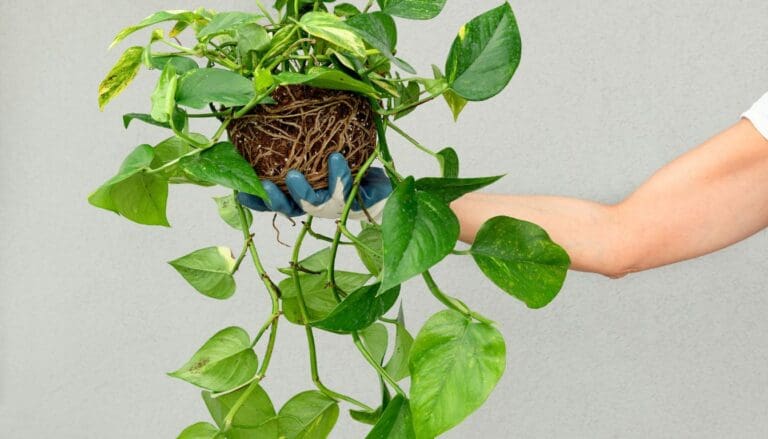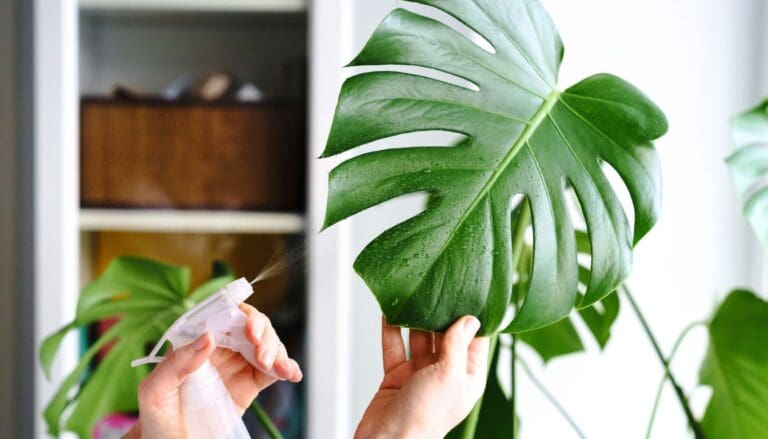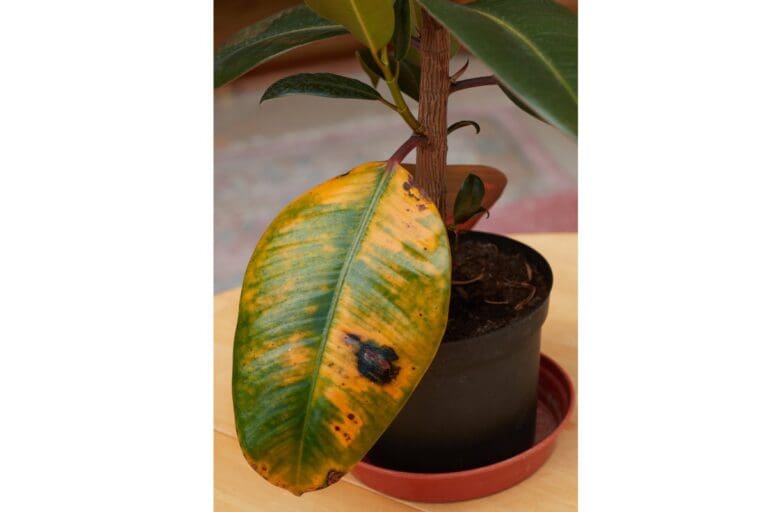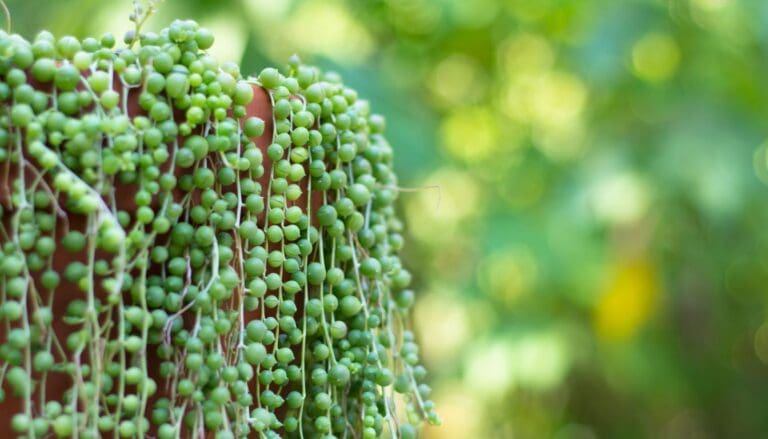5 Reasons Why Your Calathea Leaves Are Curling
Calatheas are expressive plants, and even slight discomfort can make them sick. They are outspoken plants and, when neglected, show signs of damage like curly leaves.
But what causes curly leaves in calathea? How can you fix curling in calathea? Let’s find out.
Underwatering is the primary cause of curly leaves in the calathea plant. Calathea prefers moist soil, and if their soil gets dry, the plant starts showing signs of dehydration which includes drooping and curling leaves. Other causes of curling include low humidity, excessive heat, and pests.
In this article, we will enrich the minds of our readers about the causes and remedies of curly leaves in calathea. Let’s understand every cause in brief.

Please note: Simplify Plants is reader-supported. Some links in the post are affiliate links and I get a commission from purchases made through links in the post.
Why are my calathea leaves curling up?
Brown leaves with inward curls at the edges are a sign of stress of some kind. Dehydration is the most common reason that causes leaves to curl, but it isn’t the only issue.
Plants try to compensate for the loss of water due to underwatering, reducing the leaf’s surface area by curling them. Curling the leaves will allow the plant to utilize less water from the dry soil.
The Causes of curled leaves in Calathea are:
Inadequate watering
Calathea prefers moist soil, but it shouldn’t be drenched in water. Weekly watering is best for your calathea plant. Keep a record of how frequently you are watering your plant.
Before every round of watering, inspect the moisture level of the soil. Use a moisture meter or just your fingers and stick it into the 2-6cm top layer. If the layer is dry, then water it or else leave it.
Underwatering your Calathea will cause curled leaves and other issues like wilting, crisp, and dry leaves with brown tips. Sometimes overwatering can also cause curling leaves, but it takes time.
The water utilized by your plant is a solution of minerals and nutrients from the soil. In the wild, the supply of water and nutrients is even more than the plant’s demand. But, indoors, the water content is limited so are the nutrients from the soil.
Thus, to compensate for water loss, leaves tend to reduce the surface area by curling. To an extent, curling reduces the surface area of the plant and helps it to use water for other operations.
Like other houseplants, Calathea is like moist soil. A dry environment upsets them. To keep your plant healthy, use water spray around your plant. The mist will help to control the moisture level to some extent.
Also read: How Often To Water Calathea? (A Complete Calathea Watering Guide)

Low Humidity
Tropical houseplants are fans of moisture and humidity, so is Calathea. Calathea originated from tropical areas of the World, so at least 50% humidity in the atmosphere is their happy place.
Due to the lack of humidity in their surrounding atmosphere, the plant’s moisture level also falls. Dehydration is the first thing responsible for curly leaves in your calathea.
To reduce the transpiration rate and loss of water, the leaves of the plant curl. Curling will reduce the surface area of operation, allowing for utilizing less water from the soil.
After days or months of dehydration, the cells of the plant at the edge die. Turning those parts curly, brown and unhealthy.
Sometimes, curling leaves due to low humidity is also mistaken as a sign of underwatering by some home gardeners.
Learn to identify the correct cause behind your unhealthy plant.
Also read: Should I Mist My Calathea Plant? (Calathea Humidity Requirements)

Excessive Heat
Even in their natural habitat, Calatheas are sensitive to excessive heat. Calathea can receive excessive heat either from direct sunlight or in the spot where you have placed it.
The heater, air conditioner outlet, or other machines that we generally use at our house are strictly prohibited for these plants.
Household machines that emit heat waves can cause severe chemical burns to your plants. Chemical burns can be identified by closely observing your Calathea leaves. Due to burns, leaves curl, turn brown, and become crisp.
Direct rays from the sun will cause sunburns to your calathea. We agree that Calathea loves bright light, but direct sunlight will heat the plant, drying off the leaves.
Direct heat evaporates the moisture in the leaves, which will further lead to several damages.
Also read: What Temperature Can Calathea Tolerate? (Ideal Temperature Range)

Overfertilization
Calathea doesn’t need much fertilization, but a little touch to nutrition is not too much. It helps to enhance their growth and health. Fertilizers with an NPK (Nitrogen, Phosphorus and Potassium) ratio of 10:10:10 are suitable for Calathea.
Home gardeners can also switch to organic fertilizers like cow manure, peat, vegetables, fruit compost, worms, etc. They are more effective and don’t need much care while using them.
Fertilize your Calathea plant whenever you detect that they need some care and external nutrition. Monthly fertilization is enough for your calathea to withstand the entire month.
We encourage fertilization when needed, but frequent or inadequate fertilization is harmful to your plant.
Fertilizers have a higher content of salt in them. Due to over-fertilization, the salt content of the soil exceeds the natural moisture content of your plant.
The natural moisture in your plant will start oozing out to the area where it has less moisture due to high salt content. The region with a relatively higher water percentage tends to move to a lower water percentage. This process is called Osmosis.
Over-fertilization will drain all the natural moisture from the plant and make it curly, brown, and crisp.
We know that fertilization is essential for the growth and development of the plant. But before fertilizing, gain thorough knowledge about fertilizers and methods of fertilizing. Read articles to know the exact fertilization needs of your Calathea.
Also read: Should I Fertilize Calathea? (How Often+Best Fertilizer)

Pests
The unwelcomed members like Spider mites, Fungus gnats, Mealybugs, Aphids, etc., can also lead to the curling of leaves in your calathea plant. Spider mites are common pests that you will see in the plant.
If you see that some leaves are curled with white or yellow patches on them, undoubtedly pests are the reason behind it.
Pests settle down on the leaves, suck up the nutrients from leaves and stems, and feed on the leaves to survive. Lack of nutrition due to pests makes the leaves and stem weak, making the plant floppy, wilted and unhealthy.
Calatheas are used to enhance the beauty of your room or commercial office, but an unhealthy plant will never do so. Thus, take proper care of your plant.
In case of pests, use pesticides or homemade remedies to get rid of them.
Also read: Do Calathes Attract Bugs? (Common Pest+Solution)

Remedies for Pests:
Pesticides for different pests are widely available in the market. Identify the type of pest and take effective measures according to it.
If you want to switch to a safer option, then home remedies are a lifesaver. You can prepare essential oils with Neem, Rosemary, Thyme, Clove, Mint. Put them in oil for a few hours.
Mix one teaspoon of essential oil and mix it in 1L of water. Pour it into a bottle and spray it all over the plant.
You can also try sticking some peeled garlic cloves in the soil. The pungent odor of garlic will make the small bugs uneasy.
Damage in the roots due to root rot
Sometimes, overwatering can also cause the curling of leaves in your Calathea. Root rot is caused due to overwatering, where roots of your plants are rotten due to suffocation and poor drainage facility.
The soggy soil fails to allow air from passing through the roots. Root rot restricts the power of your plant to absorb nutrients from the soil and pump it to the different parts of the plant.
The functioning of roots is disturbed. They can hardly take up nutrients and water from the soil due to root rot. Limited nutrients are supplied to the leaves and stem of the plant.
Insufficient nutrition cannot cope up with the demands of the plant and eventually turns the leaves of the plant brown and curly.
Leaves of your calathea turning curly is the first sign of root rot. That’s why we always advise our house plant gardeners to know their plants correctly.
Root rots that are identified at early stages are always curable.
Identifying the first signs is easy for those who have studied their plants. If you are adequately aware of the cause, then finding remedies is easy.
Also read: How To Save Calathea From Root Rot? (Early Signs, Causes & Solution)

How do I stop my leaves from curling?
You can always fix issues. If identified at an early stage, the curly leaves on Calathea can be fixed. We have mentioned many reasons that might cause the issue.
Do read all the above reasons thoroughly and try to identify the problem. Understanding your plant is the first step towards a healthy house plant.
Let’s find out some measures that will prevent your beautiful houseplant Calathea from having curly leaves.
- Before every round of watering, stick your finger in the soil and check if the top layers are dry. Only if the top layers are dry, water your plant.
- Tap water has many harmful minerals that might affect the health of your plant. Try switching to filtered water.
- During summer, Calathea needs frequent watering as the soil dries out easily due to heat. This plant cannot withstand dry soil, so don’t forget to maintain a watering routine.
- In winters, water the plant less to avoid overwatering and root rot.
- Maintain a temperature between 65-80°F for your Calathea.
- Fluctuating temperatures will damage the cells of your plant and shock it. Shocking your house plant will bring many issues with it.
- Humidity plays a vital role in maintaining the health of your plant. If you keep your plant in a place where it will receive low humidity, hydration is necessary.
- Nowadays, humidifiers are very popular among house gardeners. It helps to maintain and control the humidity level in the surroundings of your calathea plant. So get one for your Calathea.
- Always maintain the moisture level. Misting with water spray will prevent dehydration and the curling of leaves.
- One can buy readymade pesticides from the market or try homemade remedies. Sticking peeled garlic cloves in the soil can eliminate the problem of pests to an extent.
- Essential oils mixed with water sprayed all over the plant are effective against pests.
- Keeping your plant in cold places can also lead to the curling of leaves.
- Using fertilizers is necessary. Due to limited soil, the nutrients available in that soil are also limited. Adding fertilizer ensures that your plant is receiving all the nutrition it needs.
- Using fertilizers with an NPK ratio of 10:10:10, otherwise switching to organic fertilizers like cow dung, waste from vegetables, compost, etc., are the best options.
- Root rot or a rootbound state can cause severe problems to the plant. Repot your plant when you suspect root bound or rot.
Neglecting root damages at an early stage might land you in trouble. Take the plant out of its pot, shake and loosen all the excess soil from the roots and keep it aside.
The new pot that you have chosen should be twice the size of the previous one. It should have proper drainage holes for the extra water to run out.
Remember that repotting can be hectic for you, but it’s refreshing for your plant.
Tips for a healthy Calathea

The first evidence of a healthy calathea is its beautiful, big, and lustrous leaves. Those eye-catching leaves make the plant look even more beautiful.
Proper maintenance of your Calathea will increase not only visual appearance but also its lifespan.
Always provide proper lighting to your Calathea. They prefer bright indirect light with moist soil. Also, never compromise on the soil quality, potting soil with perlite is preferable.
Calathea grows up to a height of 2 feet in one year. They don’t demand repotting often but repotting them every 12-18 months is necessary to avoid the rootbound condition.
Repotting eliminates the chance of root damage like root-bound and rot. Changing the pot, adding fresh potting soil, and light watering will surely be a fresh experience for your little plant.
Keep your plant in a place where it will receive enough light and moisture to flourish.
Source: NCBI, University of Florida, Wikipedia, Growing Indoor Plants with Success, Agriculture, and Natural Resources, University of California, Missouri Botanical Garden.
Recommended Garden Supplies
| Product Image | Our Recommended Gardening Supplies | Check Offers! |
|---|---|---|
Top Top
Top
Top
Top
Top
Top
Top
Top | rePotme Houseplant and Tropical Classic Potting Soil Mix | Check Offer On Amazon |
 Top
Top
Top
Top
Top
Top
Top
Top | Espoma Organic Indoor Plant Food | Check Offer On Amazon |
 Top
Top
Top
Top
Top
Top
Top
Top | GooingTop LED Grow Light 6000K Full Spectrum Clip Plant Growing Lamp | Check Offer On Amazon |
 Top
Top
Top
Top
Top
Top
Top
Top | Soil Moisture Meter | Check Offer On Amazon |
 Top
Top
Top
Top
Top
Top
Top
Top | Govee Hygrometer Thermometer, Bluetooth Enabled! | Check Offer On Amazon |
 Top
Top | LEVOIT Humidifiers for Large Room(Best For Plants) | Check Offer On Amazon |
 Top
Top
Top
Top
Top
Top
Top
Top | Upgraded DIY Automatic Drip Irrigation Kit, 15 Potted Houseplants Support | Check Offer On Amazon |
 Top
Top
Top
Top
Top
Top
Top
Top | Stainless Steel Heavy Duty Gardening Tool Set | Check Offer On Amazon |
 Top
Top
Top
Top
Top
Top
Top
Top | Bonide Insecticidal Soap | Check Offer On Amazon |
 Top
Top
Top
Top
Top
Top
Top
Top | Bonide 32 oz Spray Neem Oil for Organic Gardening | Check Offer On Amazon |
 Top
Top
Top
Top
Top
Top
Top
Top | Garden Safe Fungicide | Check Offer On Amazon |






